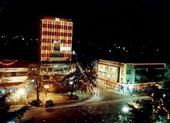Myspace Layouts at Pimp-My-Profile.com / Vineyard of germany - Image Hosting
Kavadarci is one of the best known wine growing towns in the Balkans as well as in Europe. The wines Smederevka, Kratosija, Vitac, Country white, Aleksandria and others are produced in the wine cellars of the plant Tikves and have been awarded many international awards. They are the pride of the Macedonian wine production. The town of Kavadarci is the centre of the Tikves area which got its name by the old settlement formed at the mouth of the River Tikvesica and the River Crna. The numerous objects made of Roman bricks point to the fact that it was an old Roman settlement, where the 17th century records confirmed its existence in the year 1378. Unfortunately, the construction of the reservoir Tikves has flooded all the records. By the end of the 18th century Kavadarci was mentioned under its present name as apart of the Bitola pashalik. Then it had around 2,000 inhabitants. In the period of the Turkish Empire, Kavadarci was permanent Kajmekamluk i.e. administrative centre. Today Kavadarci is a modern town with the population of 29`000 inhabitants in 9,076 households, which is even 76% of the total population of the area. It is with an absolute altitude between 230-270 m. The E-75 highway makes its geographical location favorable, because that way is only 14 km from Negotino and 11 km from Skopje-Veles-Pri1ep-Bitola motorway. With the new section above the village of Ribarci is only 100 km away from Skopje. Of the numerous cultural and historical monuments in Kavadarci and the area there a few that deserve special attention: Marko's Tower dating from the 18th century, the Church of St.Spas in the village of Pravednik built and painted in 1625, the Church of St.Atanasie south-west of the village of Galiste, the Church of St. Bogorodica in the village of Drenovo built during Tsar Dusan's reign and painted in 1356, Marko's cave church in the village of Dradnja, the Monastery of Moklis south-east of the village of Vatasa, the monastery church of which was built in 1595 by certain Nikola and his sons, the Monastery of Polog situated on the left bank of the River Crna i.e. reservoir Tikves which is only accessible by boat. The monastery church honors St.Gjorgija and dates from the 14th century. It is important, because is believed to have Dragutin's (tsar Dusan's brother) relics. The monastery yard has no inns, but there are around thirty villas around it used by the local fishermen. From the monuments of the recent history, the most.remarkab1e is the Memorial charnel house of the l2 executed boys during World War Il by the Bulgarian occupiers. It is in the village of Vatasa 4 km south of Kavadarci. Lake Tikves is the most characteristic in the area. It was formed on the River Crna in 1968. Its dam is in the vicinity of the village of Vozarci 12 km south of Kavadarci. It is the biggest reservoir in the Republic of Macedonia covering the area of 14 km2. It is 26 km long and it measures 475,000,000 m3 of water. The lake water, apart from being used for irrigating the fertile Tikves field, as well as the production of electric power, it is teeming with different kinds of fish such as: catfish, crap, tench, redfin, chub, perch and others. The water temperature during the summer period is up to 25°C and the air temperature around 26.6°C which provide favorable conditions for development of the summer tourism. Around the lake there are around 700 villas which given the proper infrastructure can contribute a great deal for the tourist economy. From the tourist attractions we can distinguish the Tikves grape picking which takes place every year in the middle of September and attracts large number of visitors. As far as the accommodation is concerned, we can single out the two hotels Balkan and Feni in the town of Kavadarci. Balkan hotel has got 24 rooms with 60 beds, whereas Feru hotel has got 160 beds. They are both of B categories. The restaurant Brioni is the most attractive in the town offering the best specialties from the Tikves area. This area is characterized by the Mediterranean climate with average air temperature of 13.5°C and average rain fall of 437.4 mm. The reason why the town hosts the biggest indoor sporting events is the construction of the sports facility Jasmin, the best indoor sports facility in the country